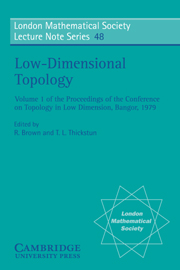Actions of compact connected groups on 4-manifolds
Published online by Cambridge University Press: 05 October 2010
Summary
Introduction
The best known examples of manifolds have large symmetry groups. In the case of 3-manifolds, S3, P3, S2 × S1, T3 and the lens spaces all admit actions by relatively “large” compact Lie groups. The manifolds of Seifert which are now known to be among the building blocks of all 3-manifolds may be viewed as 3-manifolds with (local) circle action. The purpose of this talk is to present a similarly tractable class of 4-manifolds. We shall outline the equivariant classification of 4-manifolds with compact connected Lie group actions and indicate the results and remaining questions about their topological classification. For the definitions and the basic terminology of transformation groups see Bredon's book. For simplicity we shall assume that all manifolds are closed, oriented and smooth, and all actions are differentiable. A theorem of Eisenhardt asserts that if Mm admits a G-action, then dim G ≤ ½m(m+1) and if equality holds, then Mm is Sm (or Pm). In case m = 4 we have dim G ≤ 10. The classification theorem of compact connected Lie groups asserts that G ≃ (Tk × G′)/N where G′ is a product of simply connected simple Lie groups and N is a finite central subgroup. If we allow our actions to be almost effective, i.e. allow a finite subgroup to fix every point, then we need only consider groups of the form Tk × G′.
- Type
- Chapter
- Information
- Low-Dimensional Topology , pp. 241 - 246Publisher: Cambridge University PressPrint publication year: 1982

